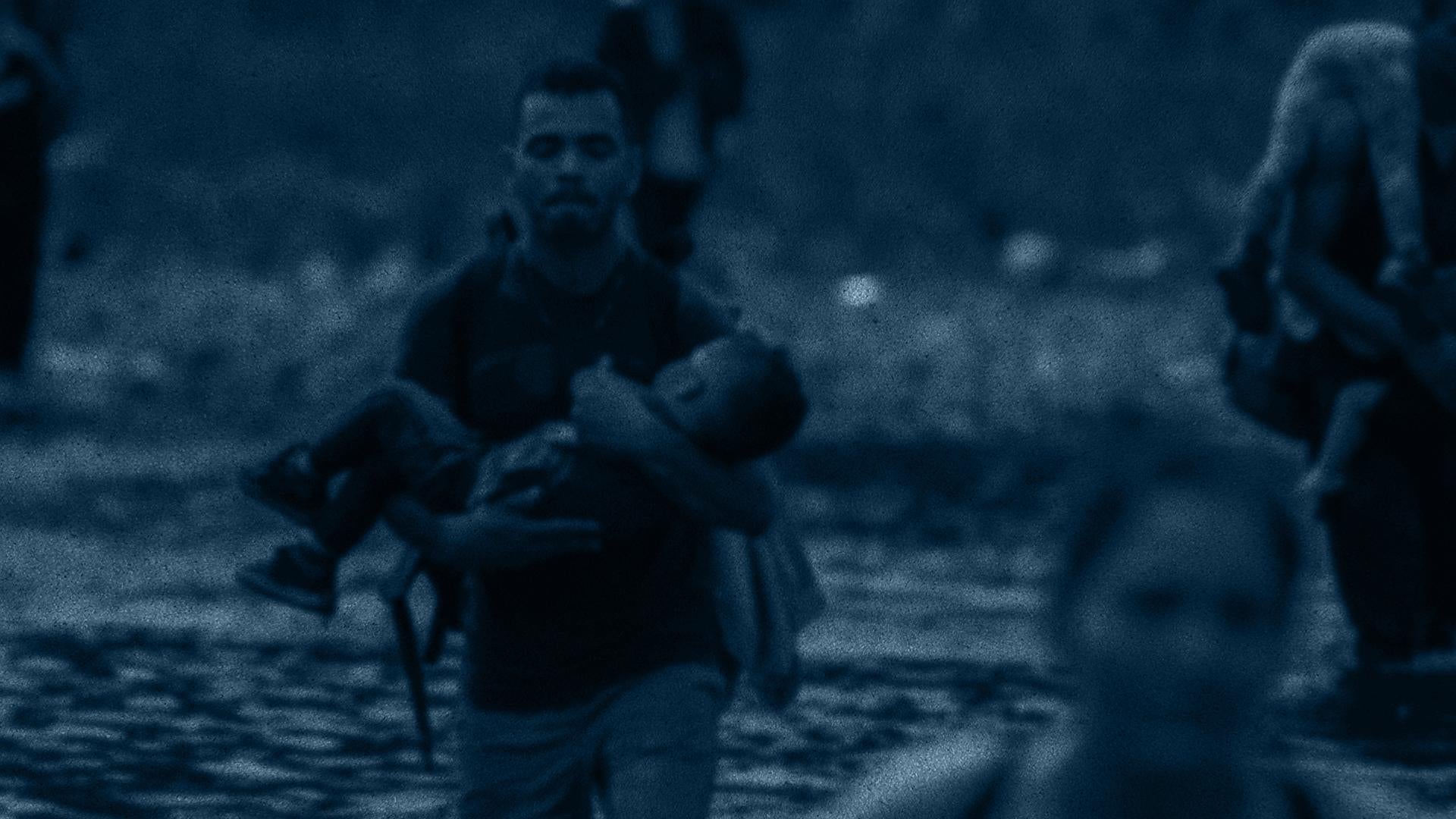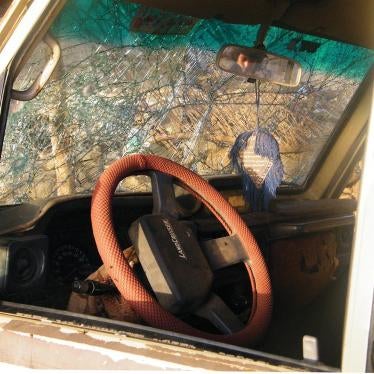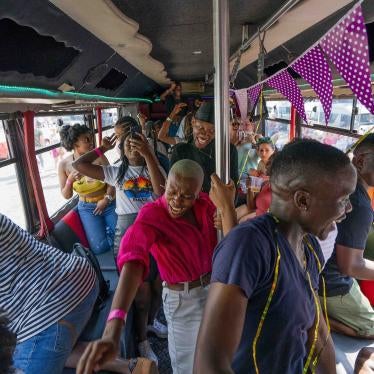(Beirut) – The parties to the conflict in Libya should allow civilians safe passage out of neighborhoods in the eastern city of Benghazi and other areas caught up in the hostilities and permit access to deliver food and medical supplies.
Residents of Benghazi whom Human Rights Watch met on April 17, 2015, and interviewed by phone on May 21 said that Libyan families and foreign civilians were trapped in downtown Benghazi affected by fighting, including areas of El-Blad, Sidi Khreibish, and El-Sabri. They said the militants controlling these areas were not allowing civilians to leave, and conditions were increasingly dire, due to food shortages and lack of medical care and because electricity to most areas had been cut. One Sidi Khreibish resident who managed to leave said that the Libyan army would no longer allow people to leave unless through a coordinated safe passage by the Libyan Red Crescent, and that militants were barring people from leaving the areas under their control.
Another Benghazi resident who had managed to leave militia-controlled areas said at least four civilians had died since March, one from gunfire and three from untreated injuries.
“As fighting in Benghazi intensifies, all the forces involved need to take all feasible precautions to minimize harm to civilians and civilian property,” said Sarah Leah Whitson, Middle East and North Africa director. “It’s vitally important for the Libyan Army and militias in Benghazi to allow civilians safe passage and to facilitate access to take badly needed aid to the people inside.”
The number of people killed and injured in Benghazi has continued to rise since Human Rights Watch visited the city in April. On May 12, a shell fired into the Ard Baloun neighborhood killed three children and injured two others from the same family, according to a local news report. Militants affiliated with the extremist group Islamic State (also known as ISIS) claimed responsibility for the attack. Two days later, one man and seven children died when a shell hit the Hay Al-Salam neighborhood, according to the website of Al-Jalaa hospital in Benghazi.
The Benghazi residents told Human Rights Watch that the Libyan Red Crescent Society had coordinated arrangements with forces loyal to the Libyan Army and the opposing militants to allow civilians safe passage out of the city’s neighborhoods until November 4, 2014. Since then, all further attempts by the Red Crescent to facilitate the evacuation of civilians had failed, including three attempts in February and March 2015, because either the militants disagreed or forces loyal to the army refused to agree, claiming that it would put the civilians’ lives at risk.
After such a failed attempt in March, an injured resident died after the Army refused to allow passage for a car carrying him insisting that residents could only leave the area by foot.
Abdelrazeq al-Nadhouri, the Libyan Army’s chief of staff, met with Human Rights Watch on April 18 at his headquarters in Al-Marj, 100 kilometers east of Benghazi. He contended that families who remained in the areas affected by fighting “wanted to stay there and refused to leave,” but said that the army would allow any who wished to do so to leave.
The same day, Zakaria Beltamer, the head of the Benghazi Crisis Committee, a body created by the Prime Ministry with several local council members and the Libyan Red Crescent, told Human Rights Watch in a separate meeting that the Red Crescent had made several calls for the evacuation of civilians, that all families had been evacuated from the affected parts of Benghazi neighborhoods, and that “whoever is still inside is with them,” meaning members of Ansar Al-Sharia or Islamist militants.
But Benghazi residents who spoke with Human Rights Watch, including a Red Crescent volunteer who helped coordinate evacuations, contradicted his assessment. The volunteer said that the Red Crescent had registered 58 people by phone in militia-controlled areas who wanted to leave but were unable to for fear of being attacked by the militias if they tried.
Beltamer said there has been widespread displacement of families from Benghazi since the outbreak of the violence in May 2014. He said that 15,000 families were registered with the Crisis Committee as internally displaced persons but acknowledged that many others had found shelter with relatives or had left the city altogether and had not registered. Benghazi, Libya’s second largest city – after the capital, Tripoli – had a population of 650,000 prior to the start of the conflict out of Libya’s total population of 6.4 million.
Under international humanitarian law – the laws of war – all forces engaged in armed conflict must allow civilians to safely evacuate from areas affected by fighting and give civilians “effective advance warning” of attacks that could put them at risk whenever circumstances permit. Even after armed forces have warned civilians of impending attacks, they must still take all feasible precautions to avoid causing loss of civilian life. This includes canceling an attack when it becomes apparent that the target is civilian or that the civilian loss would be disproportionate to the expected military gain.
Warnings such as those issued by the Libyan Army in November telling civilians to evacuate their neighborhoods do not absolve it of the duty to avoid attacks likely to cause indiscriminate or disproportionate loss of civilian life, Human Rights Watch said.
International humanitarian law also requires parties to a conflict to allow and facilitate rapid and unimpeded passage of humanitarian relief for civilians in need. Denying civilians access to food and medical care is a serious violation of international humanitarian law, and intentionally attacking personnel, installations, material, units, or vehicles involved in relief efforts is a war crime.
In the face of mounting atrocities, Human Rights Watch has called on the prosecutor of the International Criminal Court (ICC) to open an investigation into serious ongoing violations in Libya. The ICC prosecutor has jurisdiction over war crimes, crimes against humanity, and genocide committed in Libya since February 15, 2011.
During the 28th session at the Human Rights Council in March 2015, member states created a UN inquiry to investigate serious crimes in Libya since 2014. Human Rights Watch urged the office of the High Commissioner for Human Rights to speed up the deployment of the mission so it can exercise its mandate.
“With each day that passes, civilians who remain trapped in Benghazi neighborhoods face worsening conditions and greater peril for their lives,” Whitson said.
The Opposing Forces in Benghazi
Benghazi has been caught up in fighting since May 2014, when then-retired General Khalifa Hiftar and allied militias operating under the name “Libya Dignity” opened a military campaign against militant groups in Benghazi. The Dignity alliance in Benghazi comprises units of the Army, the Army Special Forces (Sa’eqa), and volunteer fighters. The Libyan Army is loyal to Libya’s internationally recognized government based in the eastern cities of Tobruk and Al-Bayda, and in March 2015 Hiftar was named commander of the army.
In July 2014, the militant groups Ansar Al-Sharia, Rafallah Al-Sahati, and Libya Shield Forces, some of the militant groups the army is fighting in Benghazi, formed the Benghazi Revolutionaries Shura Council (BRSC), which opposes the internationally recognized government and is allied with the rival self-declared government based in Tripoli. Members of groups that have pledged allegiance to the extremist group Islamic State (also known as ISIS) are also fighting the Libyan Army alongside the BRSC but are not in formal military alliance with the BRSC, Benghazi residents say.
Accounts by Residents
Due to the ongoing military operations and movement restrictions, Human Rights Watch was unable to enter the downtown areas of Benghazi to independently confirm the numbers or locations of trapped civilians.
A Benghazi resident whose father and brother had managed to flee the downtown area just a day before told Human Rights Watch on April 17, 2015, and in a call on May 21, that he knew of 50 to 60 houses in ‘ El Blad that remained inhabited with at least 15 to 20 families, as well as at least 15 families who remained in El-Sabri, and about 60 houses in Sidi Khreibish, 10 of which were inhabited by Libyan families and the rest by foreign families, including Syrians, Palestinians, and Asian and African nationals. The resident also said the most difficult area to assess was El-Sabri because it was controlled by groups affiliated with ISIS. He believed several dozen families were still in El-Sabri, close to the sea, but had no contact with them.
The resident said that while some young men refused to leave, most families were anxious to evacuate to less dangerous areas. “Most families thought it would be a matter of weeks before the war in their area was over, so they opted to stay and take care of their houses,” he said. “However, they are now stuck there, including women, children, and elderly.”
He said it had taken only three days for the Libyan Army to gain control of the Salmani neighborhood, leading many families to think that other areas would also be quickly cleared of BRSC and other militants.
He also said that his family had left their home in downtown Benghazi on November 3, 2014, under a safe passage that the Red Crescent had arranged, but that his father and brother had stayed to take care of the house. They left only on April 16, 2015:
They swam [through the sea, along the coast] for four hours at night and I was waiting for them when they arrived to safety. Those trapped have some dry food stocks, yet no medical treatment as the only field clinic belongs to the militant group Ansar Al-Sharia and they don’t treat sick or injured civilians. Most areas have no power and people charge their mobile phones in their cars.
He said the escape of his father’s and brother’s escape had been dangerous but was coordinated with the Libyan military, which had detained the two men for questioning on their arrival but released them after two days. The resident said that only a few other men and one family had managed to get away from the conflict area by swimming.
The resident said he knew of four civilian deaths through information obtained by relatives in the area:
-
Abu Shawki, 75, a Palestinian, died in March when a bullet hit him in the head as he walked along Al-Sharif Street in Sidi Khreibish;
-
Ossma Al-Greitli, 65, died in early April from injuries he sustained in February when he was hit by shrapnel in El-Gzeir Street. He had not received any medical treatment;
-
An unnamed Syrian national also died in early April, two days after shrapnel hit him in the abdomen as he was leaving the Old Mosque in the downtown area. No medical care was available; and
-
Ahmed al-Zlitni died in mid-March at his home in the El-Sabri neighborhood from a lack of medical treatment after he was burned in a fire caused by candles he used because of power cuts.
An unnamed Mauritanian national was found dead in front of a mosque in El-Sabri area in the first week of May. Two residents interviewed by Human Rights Watch said they believed members of ISIS affiliated militia had killed him when a group of civilians tried to leave the area which is under the militia’s control.
Another resident told Human Rights Watch on May 20 that her father was still trapped in the Sidi Khreibish neighborhood. She said that she and other family members evacuated on November 4, but that her father had stayed behind to take care of their home because he expected the army to quickly drive what the militia groups from the area.
She said that approximately 80 other families also remained in Sidi Khreibish and, like her father, existed on flour from a local bakery and tinned and dry foods obtained from supermarkets that had been shut and homes in the area. Her father and their neighbors were eating only one meal a day, she said. Power supplies to the area had been cut off four months earlier and residents had little access to phone networks and the Internet:
I am afraid for my father as things have gotten very bad. After we left in November, we repeatedly attempted to coordinate with the Red Crescent for a safe passage for him and for others to leave the area but the takfiris [Islamist militias] controlling the area refused to allow the civilians out. Right now, even the army will not let anyone out of the area as there are no guarantees from the other side [Islamist militias].
A volunteer at the Libyan Red Crescent Society, who is in charge of the evacuations of civilians from the downtown areas of Benghazi, told Human Rights Watch on May 21 the Red Crescent had only registered 28 Libyan nationals and 30 foreigners by telephone, including some women and children, who remained trapped in the downtown area. The Red Crescent has had no access to the area since November, the volunteer said. The volunteer acknowledged that many families and individuals did not register with the Red Crescent for fear of being targeted by the extremists or because they sympathized with them:
Despite assurances by the army that everyone would be allowed to exit the areas, including the injured of the other side [Islamist militia groups], many people who are inside the downtown area are afraid of the extremists. We were informed that one man who used to negotiate with them [Islamist militia groups] has now gone missing and hasn’t been heard of for five days. It has become very complicated for us, as there is no longer one person or a single group side to coordinate with. There are at least three, with Ansar Al-Sharia, The Libyan Shield Forces, and those loyal to the Islamic State, dividing the downtown area between them.







